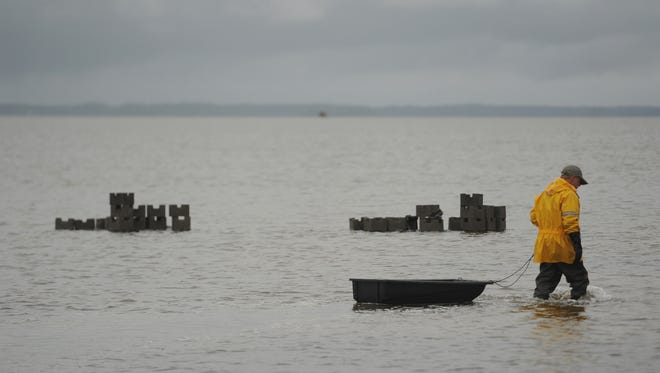NEWS
Oyster castle construction on Assateague

A volunteer wades by piles of concrete blocks used to make oyster castles at Chincoteague National Wildlife Refuge on Assateague Island on Friday, May 6, 2016. The concrete structures provide a base for oysters to attach and eventually grow into an oyster reef, which refuge officials and the Nature Conservancy hope will greatly reduce nearby shoreline erosion.
Staff Photo By Jay Diem
Oyster castles have been placed along Beach Road at Chincoteague National Wildlife Refuge on Assateague Island. The concrete structures provide a base for oysters to attach and eventually grow into an oyster reef, which refuge officials and the Nature Conservancy hope will greatly reduce nearby shoreline erosion.
Staff Photo By Jay Diem
A ruddy turnstone takes off from an oyster castle placed along Beach Road at Chincoteague National Wildlife Refuge on Assateague Island. The concrete structures provide a base for oysters to attach and eventually grow into an oyster reef, which refuge officials and the Nature Conservancy hope will greatly reduce nearby shoreline erosion.
Staff Photo By Jay Diem
Bo Lusk, Coastal Scientist for the Nature Conservancy, shows volunteers a diagram for how to costruct an oyster castle on Friday, May 6, 2016 at the Chincoteague National Wildlife Refuge on Assateague Island. The concrete structure provides a base for oysters to attach and eventually grow into a reef, which will protect nearby shorelines from erosion.
Staff Photo By Jay Diem
Volunteers gather at Chincoteague National Wildlife Refuge on Assateague Island on Friday, May 6, 2016 to help construct oyster castles. The concrete structures provide a base for oysters to attach and eventually grow into an oyster reef, which refuge officials and the Nature Conservancy hope will greatly reduce nearby shoreline erosion.
Staff Photo By Jay Diem
An oyster castle on land is used to demonstrate to volunteers how to place the concrete blocks to properly create them in the water at Chincoteague National Wildlife Refuge on Assateague Island on Friday, May 6, 2016. The concrete structures provide a base for oysters to attach and eventually grow into an oyster reef, which refuge officials and the Nature Conservancy hope will greatly reduce nearby shoreline erosion.
Staff Photo By Jay Diem
Piles of concrete blocks used to make oyster castles wait in the water for volunteers at Chincoteague National Wildlife Refuge on Assateague Island on Friday, May 6, 2016. The concrete structures provide a base for oysters to attach and eventually grow into an oyster reef, which refuge officials and the Nature Conservancy hope will greatly reduce nearby shoreline erosion.
Staff Photo By Jay Diem
Concrete squares are stacked on land to demonstrate to volunteers how to construct an oyster castle at Chincoteague National Wildlife Refuge on Assateague Island on Friday, May 6, 2016. The concrete structure provides a base for oysters to attach and eventually grow into an oyster reef, which refuge officials and the Nature Conservancy hope will greatly reduce nearby shoreline erosion.
Staff Photo By Jay Diem
Volunteers wade by piles of concrete blocks used to make oyster castles at Chincoteague National Wildlife Refuge on Assateague Island on Friday, May 6, 2016. The concrete structures provide a base for oysters to attach and eventually grow into an oyster reef, which refuge officials and the Nature Conservancy hope will greatly reduce nearby shoreline erosion.
Staff Photo By Jay Diem
A duck blind at Chincoteague National Wildlife Refuge on Assateague Island.
Staff Photo By Jay Diem
Oyster castles have been placed along Beach Road at Chincoteague National Wildlife Refuge on Assateague Island. The concrete structures provide a base for oysters to attach and eventually grow into an oyster reef, which refuge officials and the Nature Conservancy hope will greatly reduce nearby shoreline erosion.
Staff Photo By Jay Diem
Piles of concrete blocks used to make oyster castles line the water as they wait for volunteers at Chincoteague National Wildlife Refuge on Assateague Island on Friday, May 6, 2016. The concrete structures provide a base for oysters to attach and eventually grow into an oyster reef, which refuge officials and the Nature Conservancy hope will greatly reduce nearby shoreline erosion.
Staff Photo By Jay Diem
Oyster castles have been placed along Beach Road at Chincoteague National Wildlife Refuge on Assateague Island. The concrete structures provide a base for oysters to attach and eventually grow into an oyster reef, which refuge officials and the Nature Conservancy hope will greatly reduce nearby shoreline erosion.
Staff Photo By Jay Diem
A trio of birds fly by piles of concrete blocks used to make oyster castles at Chincoteague National Wildlife Refuge on Assateague Island on Friday, May 6, 2016. The concrete structures provide a base for oysters to attach and eventually grow into an oyster reef, which refuge officials and the Nature Conservancy hope will greatly reduce nearby shoreline erosion.
Staff Photo By Jay Diem